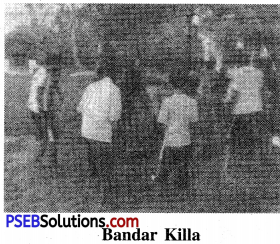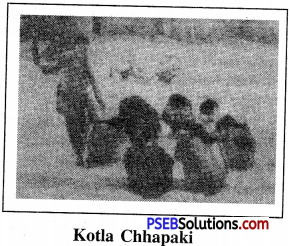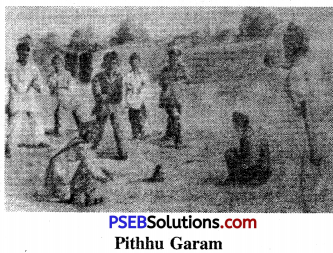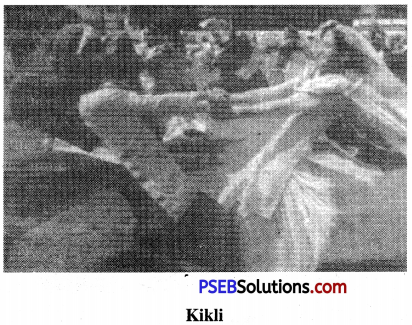Punjab State Board PSEB 6th Class Physical Education Book Solutions Chapter 4 Folk Games of Punjab Textbook Exercise Questions and Answers.
PSEB Solutions for Class 6 Physical Education Chapter 4 Folk Games of Punjab
Physical Education Guide for Class 6 PSEB Folk Games of Punjab Textbook Questions and Answers
Question 1.
Name any two games of Children.
Answer:
Bandar Killa and Gulli Danda.
Question 2.
How many ways are there of ‘Pugatta’? Explain anyone.
Answer:
There are two methods of Pugatta.
First Method:
First of all three players place their right hands on one- another’s hands and toss their hands together in the air and then they are reversed or kept straight. If hands are placed upturned by two or three players and the third player’s hands remain straight, then that player is supposed to be ‘puggna’. In this way one by one all the players except one supposed to be ‘puggna’. If the position of the hands of all the three players is same, it means either their hands are upright straight reversed.
![]()
Question 3.
Write a note on the importance of the folk games.
Answer:
While children play different games. Every game teaches different qualities to the child. They become strong, active & alertness in brain. Kotla Chipaki game increases quickness in the child! Pithu Garam and aiming with Catapult make the child a good shot and Bandar Killa teaches how to be defensive. Wrestling & Kabaddi increase the physical strength. All these games even make the brain sharp. It makes understanding among the children & we can heritage our folk games.
Question 4.
Describe the method of playing the game ‘Bandar Killa’.
Answer:
It is very famous game of children. Children get together in the lanes of colony & find the place for Killa (Peg) to play the game of Bandar Killa. The children address each other by singing on starting the game.
‘Juttian-chapplan da,
Kar lo ve heela.
Hun apan rail ke,
Khedna Bandar killa.’

In this game children take off their shows & place them near the peg then they tie a rope of 5-7 metres at the bottom of the peg. All the children play the game of Bandar Killa. Do ‘puggatta’ for fixing the turn for any child. All the children after ‘pugatta’ select the child for the ‘turn’. This selected child is called ‘Bandar’. A children who make Bandar hold the rope which was tie to the peg & guard the heap of shoes. The child without leaving the rope will try to touch any child.
The other players without being touched by the .Bandar try to pick up the shoes & chappal if the Bandar touches any child while picking the chappals that child becomes Bandar. If all the children become successful in picking all the shoes & chappals without being touched by the Bandar all will run towards the place to be touched which is already fixed. All the children beat the Bandar with shoes until he reaches the fixed place as soon as Bandar reaches the fixed place beating with shoes stopped. After this another child will take the turn to perform as Bandar.
![]()
Question 5.
Which folk game do you like the most? How is it played?
Answer:
Our most wanted game is Kotla Chhapaki. In this game there is no counted of children. This game is also known as Kaji ‘Kotle di Maar.’ This game is played by 10-15 children. Children prepare a kotla making a thick rope of cloth after twisting. Then a child draw a circle with a sharp object on the ground. All the children set on the edge of the drawn circle facing inside. Now the child whose turn is fixed runs outside the circle with kotla and sing the song-
‘Kotla chhapaki, jumme raat ayie
Jehra agge-pichhe dekhe, ohdi shamat ayie’.
A child, who takes the turn runs around the children by repeating same song. No child can see at the back in this game. All the children keep their heads down. If any child looks at the back a child who takes his turn give 4-5 beats with this kotla. After running he keeps kotla behind any child & completes his round & comes back to the same child. Where he has kept kotla. If the child behind kotla at the back is placed does not aware about kotla. The child who is taking round start beating him with his kotla.

The child who is being beaten starts running very fast around the circle to escape his beating he has to bear beating of the kotla until he reaches back to his seat. If the child notices about kotla he picks the same & beats the child on his turn. He keeps on beating until he takes round & places the weekend seat.
PSEB 6th Class Physical Education Guide Folk Games of Punjab Important Questions and Answers
Multiple Choice Questions
Question 1.
Method of Pugna:
(A) Two
(B) Three
(C) Four
(D) Five.
Answers:
(A) Two
![]()
Question 2.
Name the Folk game of your choice.
(A) Bandar Killa
(B) Kotla Chhapaki
(C) Rope Skipping
(D) None of them.
Answers:
(A) Bandar Killa
Question 3.
Name two games:
(A) Hockey
(B) Football
(C) Cricket
(D) All above.
Answers:
(A) Hockey
(B) Football
Question 4.
Write two Folk games:
(A) Bandar Killa and Kotla Chhapaki
(B) Thief and Police man
(C) Rope Skipping
(D) Circle Kho-Kho.
Answers:
(A) Bandar Killa and Kotla Chhapaki
Question 5.
Write the importance of folk games.
(A) Development of body and mind
(B) Activeness
(C) Attentiveness
(D) All above.
Answers:
(D) All above.
![]()
Very Short Answer Type Questions
Question 1.
Write any two names of folk games.
Answer:
Kotla Chhapaki
Kikli.
Question 2.
Write the song of Kotla Chhapaki.
Answer:
‘Kotla Chhapaki, jumme raat ayie
Jehra agge-pichhe dekhe, ohdi shamat ayie.’
Question 3.
Write four lines of ‘Bandar Killa’.
Answer:
Juttian-chapplan da,
Kar lo ve heela,
Hun apan rail ke,
Khedna Bandar Killa.
Question 4.
Write how many methods of Pugatta?
Answer:
There are three methods of pugatta.
Question 5.
Write any folk game do you like most.
Answer:
Bandar Killa.
Question 6.
Which is the best game for health?
Answer:
Rope skipping.
Question 7.
Which game provide activeness, alertness and concentration?
Answer:
Pithhu Garam.
![]()
Question 8.
Write one name of big and one name of folk games.
Answer:
Hockey & Kotla Chhapaki.
Question 9.
Write one importance of folk games.
Answer:
Body become healthy.
Question 10.
Who plays the kikli?
Answer:
It is for girls.
Short Answer Type Questions
Question 1.
What is play?
Answer:
Play is a that activity which is performed for recreation and from these activities we get pleasure.
Question 2.
Write the types of games.
Answer:
We can describe the games in many ways-
- Physically games
- Mentally games
Our games like Cricket, Hockey, Volleyball, Football are those type of games by playing these games, we require a lot of equipments and particular playfield which are played under certain rules. Folk games are contrary of these games.
Question 3.
At what age people play the games?
Answer:
Games are played at every age-children, young & elder people. Boys & girls both play the games.
Question 4.
How can we divide our games?
Answer:
Our games like Cricket, Hockey, Football etc.
![]()
Question 5.
Which are the important rules of playing the folk games?
Answer:
In these games we don’t require any equipment & certain rules.
Question 6.
What are main rules of big games?
Answer:
In big games equipments, playfield & particular rules are required. These games are played under certain rules.
Question 7.
Write the method pugatta in folk games.
Answer:
First of all three players place their right hands on one-another’s hands & toss their hands together in the air and then they are reversed or kept straight. If hands are placed upturned by two or three players and the third player’s hands remain straight then that player is supposed to be puggna. In this way one by one all players supposed to be puggna.
Question 8.
Write the song of pugatta of second method.
Answer:
“Eengan meengan tadi talingan
Kala, peela, dakkra
Gurh khawan, vail wdhawan,
Mooli patra
Pattan Waley, ghorre aye,
Hath Kutarri, Paer kutarri
Nikkal baleya teri wari.”
Question 9.
Is their any division of team in folk games?
Answer:
Yes, in many games we divide the players in two teams like- Gulli Danda, Kabaddi etc.
![]()
Question 10.
Write the five names of folk games.
Answer:
Bandar Killa, kotla Chhapaki, Kikli, Pittu Garam, Skipping rope.
Question 11.
Write any two importance of folk games?
Answer:
By playing these games we get strength, activeness & alertness of mind. When a player aim at the thikri he know how to concentrate.
Question 12.
Write the importance of Rope Skipping.
Answer:
- This game is very important for the point view of exercise.
- It develop the strength & flexibility.
Question 13.
What is Pithhu garam?
Answer:
Pithhu garam is one of the favourite game of children. No. of children is not fixed in this game. Children are divided into two groups. Seven broken pieces of earthen ware are placed on one-another. These are called Pithhu.
Question 14.
What is the importance of Kikli?
Answer:
It is very important of punjabi girls and it is the combination of giddha.
- It help in co-ordination.
- It also help to increase understanding.
- It is main cause of recreation and using leisure time.
![]()
Long Answer Type Questions
Question 1.
Write the second method of Pugna.
Answer:
Second method of Pugna:
All players have stand in a circle. One of them players sing his hand shoulder on the other player and sing a song.
Eengan meengan tadi talingan
Kala peela, dakkra
Gurh khawan, vail wdhawan
Mooli patra
Pattan waley, ghorre aye.
Hath Kutarri, paer kutare
Nikkal baleya teri wali
The player who is touched at the sound of the last word spoken is not supposed to take his turn. He is supposed to be pugna. By using this method again and again, the player is left in the end, get his turn fixed.
Question 2.
Write about the rope keeping and pithhu kho game.
Answer:
It is very important Khel for exercises after pugna, two players remain they stand against each other and swing the rope by put in slope and rotate the rope in one side. The other player in a line by one by one take two steps in the rope. Those players who will touch the rope while
jumping we go out and takes the turn rotating the rope. This game is very important and recreational but in these days it is diminished.
Pithhu Garam:
In this game the player beats at the back of the other player. It is also very favourite game of the students in Punjab. Children are divided into two groups. Seven broken pieces of earthenware are placed on one another. These are called Pithu. A line is drawn at a distance of 10-15 feet from the pieces which are put in an orderly manner, both teams perform pugatta.

Any player of the winner team stand of the line and try to hit ordinary player placed pieces of earthenware with ball. A player gets three chances to hit the target. If he is unable to hit the target, he is declared out of the game. If the ball is got after one balance by the opposite even then the player hitting the pieces is declared to be out. If a player hitting them successfully and scattered them to be out. It is known as breaking of the pithu. After breaking the pithu the hitter tries to collect all the pieces meanwhile the member of the opposite team hits the player collecting the pieces with the ball. If the player places the pieces before he is hit with a ball he deserves another turn. The other player takes his turn to hit him. In this way the game starts again.
![]()
Question 3.
Write about the Kikli.
Answer:
Kikli is a famous game among girls of Punjab. Kikli means happiness and it creates the voice of interest. Kikli game is a combination of giddha which is played by girls with great interest. The girls gathered in a particular place join hands with hands of other girls and start moving around. They catch the opposite hands of the girls and make a shape of figure eight (infinity°o). While rotating they sing a song:
Kikli Kallir di
Pagg mere veer di
Duppatta Bharjai da
Phite muh Jawai da.

In this way, while participating in Kikli they start competition. When any one of the girls leaves her hands and falls down, the other girls make a shout of joy after her fall. In this way the girls enjoy the game very well.
